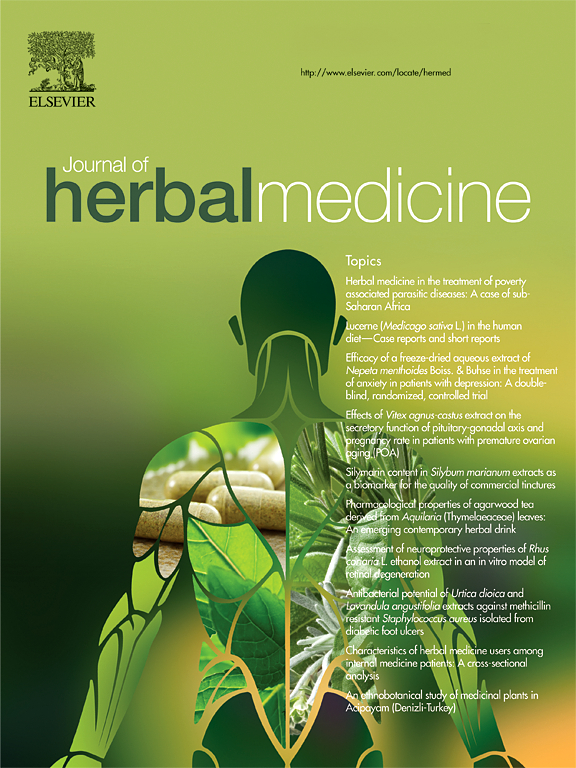Anti-inflammatory and Antiproliferative Properties of Aqueous Extracts From Capparis spinosa L. Aerial Part on Skin Cancer Cells and Microglial Macrophage
IF 1.9
4区 医学
Q2 INTEGRATIVE & COMPLEMENTARY MEDICINE
引用次数: 0
Abstract
Introduction
Caper refers to the genus Capparis and it is known in Morocco via the Berber vernacular name of ‘Taylaloute’ and the Arabic name ‘kabâr ou Lkbbar.’ In addition to its use as a condiment, for several centuries, Capparis spinosa L. (C.s) has been utilised in traditional medicine for the treatment of several diseases. This study aimed to assess the antiproliferative and anti-inflammatory effects of the aqueous infusion of C. s leaves originating in Morocco.
Methods
The antiproliferative effect was evaluated on the A431 cell line, which is an epidermal carcinoma derived from skin cancer. The test was assessed by the redox indicator Alamar Bleu assay on cell viability. Moreover, the anti-inflammatory activity was evaluated on the BV2 cells (normal cells: Mouse microglial macrophage) using the nitric oxide (NO) assay and Griess reagent method. The anti-inflammatory effect was determined by the ability of extracts to inhibit the NO production by lipopolysaccharide (LPS)-activated BV2 cells.
Results
The aqueous infusion of C.s leaves showed a significant antiproliferative effect in a dose-dependent manner, leading to a reduction in cell viability percentage to 27.34%. Furthermore, the extracts led to a significant (P < 0.001) reduction in NO production by BV2 cells activated with LPS to 6.82 µM/ml NO compared to 17.12 µM/ml for the positive control (LPS-activated BV2 cells).
Discussion/Conclusions
In light of the obtained results, it is evident that C.s has important pharmacological properties, which support its traditional use as an anticancer and reduce various inflammatory affections.

刺毛柑地部水提物对皮肤癌细胞和小胶质巨噬细胞的抗炎和抗增殖作用
caper指的是Capparis属,在摩洛哥通过柏柏尔人的方言名称“Taylaloute”和阿拉伯语名称“kab r ou Lkbbar”而闻名。几个世纪以来,除了用作调味品外,刺毛椒还被用于传统医学中治疗多种疾病。本研究的目的是评估水浸对原产于摩洛哥的蛇麻叶的抗增殖和抗炎作用。方法对一种由皮肤癌衍生的表皮癌A431细胞株进行抗增殖实验。采用氧化还原指示剂Alamar Bleu法测定细胞活力。采用一氧化氮(NO)法和Griess试剂法对BV2细胞(正常细胞:小鼠小胶质巨噬细胞)进行抗炎活性评价。其抗炎作用是通过抑制脂多糖(LPS)激活的BV2细胞产生NO的能力来确定的。结果黄芪叶水浸对黄芪细胞有明显的抗增殖作用,细胞存活率降低27.34%,且呈剂量依赖性。此外,这些提取物显著(P <; 0.001)使LPS激活的BV2细胞的NO产量减少到6.82 µM/ml,而阳性对照(LPS激活的BV2细胞)的NO产量为17.12 µM/ml。讨论/结论根据所获得的结果,可见黄芪具有重要的药理作用,支持其作为抗癌和减轻各种炎症的传统用途。
本文章由计算机程序翻译,如有差异,请以英文原文为准。
求助全文
约1分钟内获得全文
求助全文
来源期刊

Journal of Herbal Medicine
INTEGRATIVE & COMPLEMENTARY MEDICINE-
CiteScore
3.90
自引率
0.00%
发文量
94
期刊介绍:
The Journal of Herbal Medicine, the official journal of the National Institute of Medical Herbalists, is a peer reviewed journal which aims to serve its readers as an authoritative resource on the profession and practice of herbal medicine. The content areas of the journal reflect the interests of Medical Herbalists and other health professionals interested in the clinical and professional application of botanical medicines. The objective is to strengthen the research and educational base of herbal medicine with research papers in the form of case studies, original research articles and reviews, monographs, clinical trials and relevant in vitro studies. It also publishes policy statements, opinion pieces, book reviews, conference proceedings and profession related information such as pharmacovigilance reports providing an information source for not only the Herbal Practitioner but any Health professional with an interest in phytotherapy.
 求助内容:
求助内容: 应助结果提醒方式:
应助结果提醒方式:


